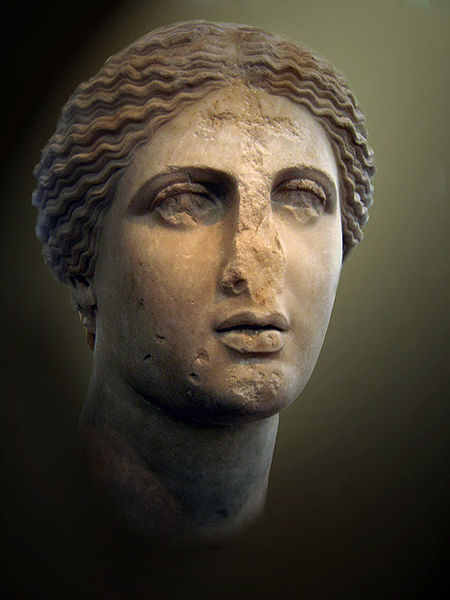Persecution of pagans in the late Roman Empire
Persecution of pagans in the late Roman Empire began during the reign of Constantine the Great in the military colony of Aelia Capitolina (Jerusalem), when he destroyed a pagan temple for the purpose of constructing a Christian church. Rome had periodically confiscated church properties, and Constantine was vigorous in reclaiming them whenever these issues were brought to his attention. Christian historians alleged that Hadrian had constructed a temple to Venus on the site of the crucifixion of Jesus on Golgotha hill in order to suppress Christian veneration there. Constantine used that to justify the temple's destruction, saying he was simply reclaiming the property. Using the vocabulary of reclamation, Constantine acquired several more sites of Christian significance in the Holy Land.

Head of Aphrodite, 1st century AD copy of an original by Praxiteles. The Christian cross on the chin and forehead was intended to "deconsecrate" a holy pagan artifact. Found in the Agora of Athens. National Archaeological Museum in Athens.
Rome-Capitole-StatueConstantin
Early coin of Constantine commemorating the pagan cult of Sol Invictus
A cult statue of the deified Augustus, deconsecrated by a Christian cross carved into the emperor's forehead
Anti-paganism policies of the early Byzantine Empire
The anti-paganism policies of the early Byzantine Empire ranged from 395 till 567. Anti-paganism laws were enacted by the Byzantine Emperors Arcadius, Honorius, Theodosius II, Marcian and Leo I the Thracian. They reiterated previous legal bans, especially on pagan religious rites and sacrifices and increased the penalties for their practice. The pagan religions had still many followers but they were increasingly obliged to keep under cover to formally comply with the edicts. Significant support for paganism was present among Roman nobles, senators, magistrates, imperial palace officers, and other officials.
Head of Aphrodite, 1st century AD copy of an original by Praxiteles. Christian cross defacing the chin and forehead. Found in the Agora of Athens. National Archaeological Museum in Athens.




